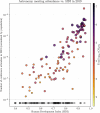Astronomy's climate emissions: Global travel to scientific meetings in 2019
- PMID: 38694146
- PMCID: PMC11060108
- DOI: 10.1093/pnasnexus/pgae143
Astronomy's climate emissions: Global travel to scientific meetings in 2019
Abstract
Travel to academic conferences-where international flights are the norm-is responsible for a sizeable fraction of the greenhouse gas (GHG) emissions associated with academic work. In order to provide a benchmark for comparison with other fields, as well as for future reduction strategies and assessments, we estimate the CO2-equivalent emissions for conference travel in the field of astronomy for the prepandemic year 2019. The GHG emission of the international astronomical community's 362 conferences and schools in 2019 amounted to 42,500 tCO2e, assuming a radiative-forcing index factor of 1.95 for air travel. This equates to an average of 1.0 ± 0.6 tCO2e per participant per meeting. The total travel distance adds up to roughly 1.5 Astronomical Units, that is, 1.5 times the distance between the Earth and the Sun. We present scenarios for the reduction of this value, for instance with virtual conferencing or hub models, while still prioritizing the benefits conferences bring to the scientific community.
Keywords: astronomy and astrophysics; climate-change impacts; climate-change mitigation; conferences and meetings.
© The Author(s) 2024. Published by Oxford University Press on behalf of National Academy of Sciences.
Figures







Similar articles
-
Recommendations Emerging from Carbon Emissions Estimations of the Society for Neuroscience Annual Meeting.eNeuro. 2023 Oct 16;10(10):ENEURO.0476-22.2023. doi: 10.1523/ENEURO.0476-22.2023. Print 2023 Oct. eNeuro. 2023. PMID: 37739787 Free PMC article.
-
Mobile measurements of climate forcing agents: Application to methane emissions from landfill and natural gas compression.J Air Waste Manag Assoc. 2015 Apr;65(4):404-12. doi: 10.1080/10962247.2014.996269. J Air Waste Manag Assoc. 2015. PMID: 25947210
-
['Is there a doctor on board?' Reducing air travel associated with international medical conferences].Ned Tijdschr Geneeskd. 2023 May 23;167:D7495. Ned Tijdschr Geneeskd. 2023. PMID: 37235587 Dutch.
-
Mitigation of global greenhouse gas emissions from waste: conclusions and strategies from the Intergovernmental Panel on Climate Change (IPCC) Fourth Assessment Report. Working Group III (Mitigation).Waste Manag Res. 2008 Feb;26(1):11-32. doi: 10.1177/0734242X07088433. Waste Manag Res. 2008. PMID: 18338699 Review.
-
Can virtual events achieve co-benefits for climate, participation, and satisfaction? Comparative evidence from five international Agriculture, Nutrition and Health Academy Week conferences.Lancet Planet Health. 2022 Feb;6(2):e164-e170. doi: 10.1016/S2542-5196(21)00355-7. Lancet Planet Health. 2022. PMID: 35150625 Free PMC article. Review.
References
-
- Eyring V, et al. 2021. Human influence on the climate system. Vol. 423. Cambridge, UK and New York (NY): Cambridge University Press.
-
- Intergovernmental Panel on Climate Change (IPCC) . 2023. Weather and climate extreme events in a changing climate. Cambridge, UK and New York (NY): Cambridge University Press. p. 1513–1766.
-
- International Air Transport Association (IATA) . 2019. Climate change and carbon offsetting and reduction scheme for international aviation (CORSIA) report.
-
- International Energy Agency (IEA) . 2020. Tracking transport 2020, international energy agency tracking transport report 2020.
-
- Avila D, Sherry L, Thompson T. 2019. Reducing global warming by airline contrail avoidance: a case study of annual benefits for the contiguous United States. TRIP. 2:100033.
LinkOut - more resources
Full Text Sources

